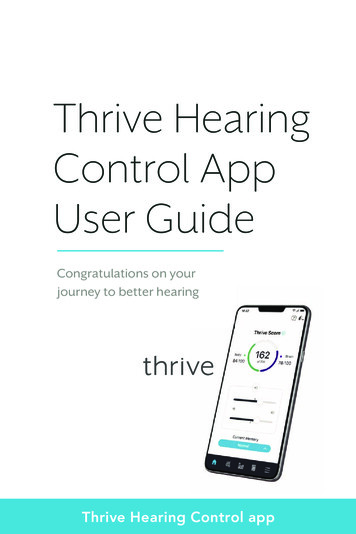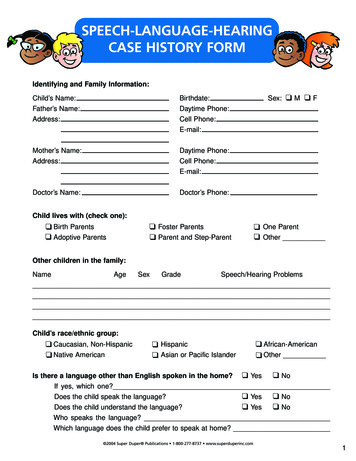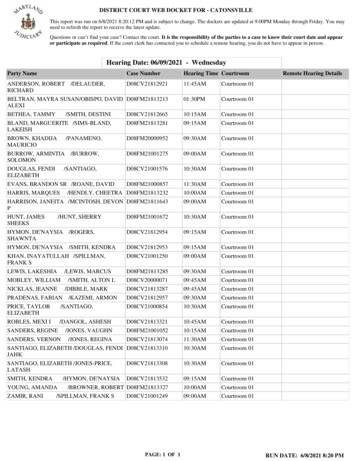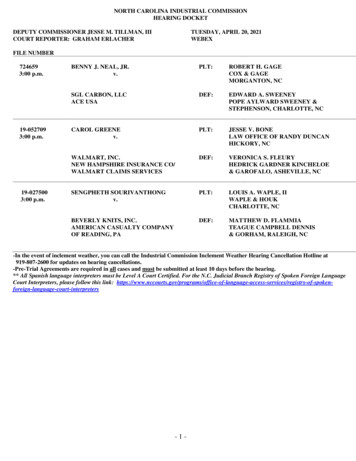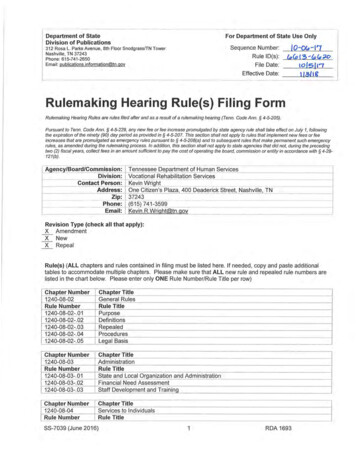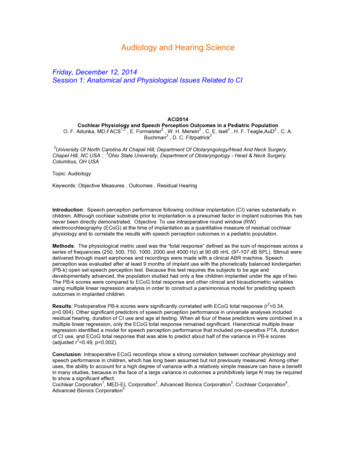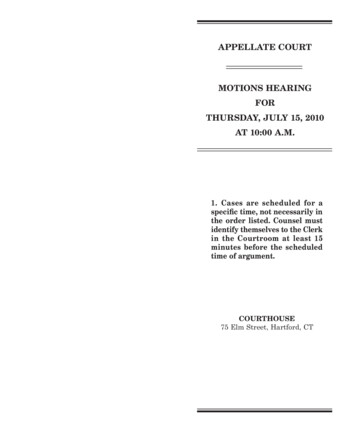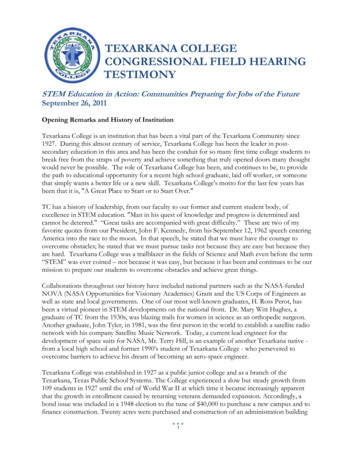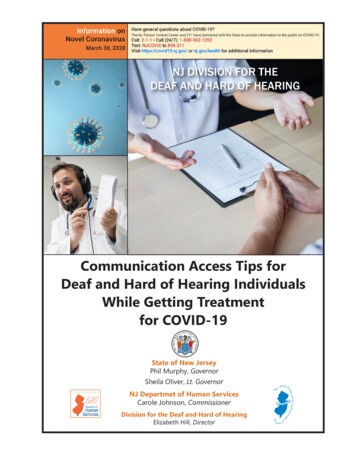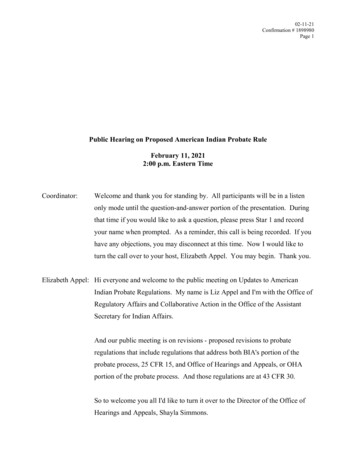
Transcription
02-11-21Confirmation # 1898980Page 1Public Hearing on Proposed American Indian Probate RuleFebruary 11, 20212:00 p.m. Eastern TimeCoordinator:Welcome and thank you for standing by. All participants will be in a listenonly mode until the question-and-answer portion of the presentation. Duringthat time if you would like to ask a question, please press Star 1 and recordyour name when prompted. As a reminder, this call is being recorded. If youhave any objections, you may disconnect at this time. Now I would like toturn the call over to your host, Elizabeth Appel. You may begin. Thank you.Elizabeth Appel: Hi everyone and welcome to the public meeting on Updates to AmericanIndian Probate Regulations. My name is Liz Appel and I'm with the Office ofRegulatory Affairs and Collaborative Action in the Office of the AssistantSecretary for Indian Affairs.And our public meeting is on revisions - proposed revisions to probateregulations that include regulations that address both BIA's portion of theprobate process, 25 CFR 15, and Office of Hearings and Appeals, or OHAportion of the probate process. And those regulations are at 43 CFR 30.So to welcome you all I'd like to turn it over to the Director of the Office ofHearings and Appeals, Shayla Simmons.
02-11-21Confirmation # 1898980Page 2Shayla Simmons: Thank you, Liz. Welcome everyone. We're glad to see so many people onthe phone today. And I just want to take a quick couple of moments to lay thebackdrop for why we're here. Many of you may know some of this and it maybe new to others.So we have been operating under the current regulations for over a decade.And over that course of that time, between BIA and the judges in the Office ofHearings and Appeals, we have begun to talk about things that we thoughtcould be improved to help make the probate process smoother, maybe a littlebit quicker.And so back in 2016 and '17 the BIA initiated some tribal consultation tocollect ideas on what changes might be beneficial. And following that, aworking group of a lot of the people who are on the call today, who will behere to be able to answer questions for you, a very hard working group ofpeople got together. And over the course of the next year and a half or so,began drafting proposed language.We regularly met with principals in our various organizations, to make surethat they were still supportive of the effort for us to go forward. And wecontinued to get the green light. So in 2019 we published an AdvancedNotice of Proposed Rulemaking and took comments at that time, and haveaddressed those comments in the current language that you will have beforeyou as the proposed rule.As I said, we continue to ensure that management above all of us, issupportive of this effort and they continue to be so. So what's important nowis that we are at the proposed rule stage. So your interest and your commentsare very welcome. We need to know if the language that has been proposed isactually going to meet the goals that it says it will meet. And so it's really
02-11-21Confirmation # 1898980Page 3important for people in the community, to look at it, you know, take a hardlook at it and provide whatever input you might have about the language thatis in the proposed rule.We'll be taking comments until March 8th. And Liz will be going through arather detailed presentation of the proposed changes. So I won't go into thathere. I just want to say once more, thank you to all of you and hope you areready with lots of comments.And to the group on the phone from Interior, that has worked so hard on this,thank you as well. I think this is - represents a wonderful cooperative effortamongst all of our offices, to get to a place where the probate regs can beimproved. Thank you.Elizabeth Appel: Thank you, Director Simmons. And we also have the Bureau of IndianAffairs, BIA, Deputy Director for Field Operations, Bart, with us today if he'dlike to make a - if you'd like to introduce yourself.Bart Stevens:Certainly. Thank you, everyone. And thanks everyone for joining thisimportant call today. My name is Bart Stevens and I'm the Acting DeputyBureau Director for Field Ops for the Bureau of Indian Affairs. I’m here toalso participate in the conversation as needed, but mainly to hear thecomments and the questions that are asked by those participating in thisconsultation.So I look forward to hearing those comments and questions and the responsesthat we will provide. But again, thanks for having me and thanks for joiningus on this important call.
02-11-21Confirmation # 1898980Page 4Elizabeth Appel: Thank you, Deputy Director Stevens. So as Director Simmons mentioned, I'llbe going through a presentation to walk through the changes to the regulationsthat are being proposed. And then when I'm done with that we'll open up thelines for your questions and comments.So we have all of our subject matter experts gathered here today from bothBIA and OHA, as well as our legal advisors from the Office of the Solicitor.So that you get familiar with our voices, I'd like to - I'd like each of them tointroduce themes, beginning with Judge Payne with the Office of Hearingsand Appeals.Judge John Payne: Hello everyone. This is John Payne, Chief Judge with the Probate HearingsDivision of the Office of Hearings and Appeals. Thank you all very much forbeing here. I’m looking forward to hearing your feedback. I've been workingon these regs for a couple of years now, so I'm looking forward to hearingwhat you have to say.Elizabeth Appel: All right, thank you. And Mary, would you like to go next?Mary Dickman:Sure. My name is Mary Dickman. I'm an attorney at the Office of Hearingsand Appeals. I participated in the - very closely, in the drafting of these regsand so - and we worked really hard on it. And we want it to be a really goodproduct, so we're thankful that folks are calling in. And we're looking forwardto hearing comments.Elizabeth Appel: Thank you. And Josh, would you like to go next?Josh Epstein:Sure thing. Hi everyone. I'm Josh Epstein. I'm an attorney in the Office ofHearings and Appeals Director's Office. So I work for Director Simmons,who you just heard from. And I have been on part of the workgroup for most
02-11-21Confirmation # 1898980Page 5of the time that this has been going on, so I have had an amazing front rowseat to all the hard work and thought that's gone into this.And I appreciate everyone calling in today as part of this public session. Ilook forward to hearing your thoughts.Elizabeth Appel: Thank you. And moving onto BIA, we have Charlene Toledo.Charlene Toledo: Hello everyone. This is Charlene Toledo. I am the Division Chief for ProbateServices for BIA. Thank you.Elizabeth Appel: Thank you, Charlene. And with our Office of the Solicitor, we have KarenLindquist.Karen Lindquist: Hi. My name is Karen Lindquist and I'm the Assistant for the branch of TrustServices in the Division of Indian Affairs. And I work in the Solicitor's Officein Washington, DC.Elizabeth Appel: Great. And Suzanne Nunn?Suzanne Nunn:Hi everyone. My name is Suzanne. I work in the Solicitor's Office in DCwith Karen. And I am the Attorney Advisor for Indian Probates. Thanks forjoining.Elizabeth Appel: Great. Thank you. And just to make sure, did anyone else from BIA joinfrom the drafting team or otherwise?Johnna Blackhair: This is Johnna.Elizabeth Appel: Oh, great. Hi Johnna.
02-11-21Confirmation # 1898980Page 6Johnna Blackhair: Good afternoon, everyone. My name is Johnna Blackhair. I'm the DeputyBureau Director for the Office of Trust Services.Elizabeth Appel: Great. Thank you, Johnna, Deputy Director Blackhair. So I am going to bewalking through a presentation. That presentation is available on the Web. Ifyou go to www.BIA.gov there is along the top toolbar sort of, there is a tab forconsultations that if you click on pulls down two items. The first is scheduleand the second is regulations, documents, and developments.If you click the regulations, documents, and developments, that will take youto a list of all the regulatory efforts that are in progress in one way or another.And at the - the last bulleted item on the first bullet list, is this proposed rule the American Indian Probate Regulation Update. And if you click that youwill see there are links to both the proposed rule and then a presentationproviding an overview of the proposed rule is available here. And the link tothat presentation is at the word here.So again, if you'd like to follow along with me, just go to BIA.gov and clickon consultations and drop down to regulations, documents and developments.And then click on American Indian Probate Regulation Update and then you'llsee after the link to the proposed rule there's a link to the presentation.So as I mentioned, at the beginning of the call, both BIA and OHA have rolesin the probate office. The BIA compiles the decedent's probate file and thatincludes an inventory of trust or restricted assets, and family and estateinformation.The BIA then transmits that probate file to the Office of Hearings andAppeals, OHA. And OHA adjudicates the probate and issues a decision as to
02-11-21Confirmation # 1898980Page 7who receives which property in the decedent's estate. At that point, BIA thendistributes the trust or restricted real property or land, and the Bureau of TrustFunds Administration, BTFA, which is - was formerly the Office of SpecialTrustee for American Indians, OST, the BTFA distributes trust funds inaccordance with the OHA's order.And if you're looking at a copy of the presentation you'll see on that next slidethere's a flowchart diagram that provides an overview of the probate process.The first step obviously is that an individual with trust or restricted propertydies. So BIA then prepares the probate file, OHA receives the probate filefrom BIA, and then OHA mails hearing notices, so notices alerting interestedparties, heirs, devisees, of the hearings. And BIA posts those hearing notices.The OHA judge then conducts the hearings and then issues a decision to theinterested parties, BIA, and BTFA. OHA then returns the administrativerecords to the BIA, and closes the case. And at that point, BIA distributes theland in accordance with the order. And BTFA distributes the trust personaltyor funds, in accordance with the order.So Director Simmons briefly brought - touched on the history of theseregulations. And the beginning really was in 2008 when the currentregulations in their current form, were put into place, to implement theAmerican Indian Probate Reform Act or AIPRA. And then in 2011 therewere some minor updates and amendments to those regulations, to addresscertain statutory updates.And then in 2016 and 2017 BIA began hosting tribal consultations andlistening sessions for ideas on how to improve the whole probate process.And in 2019 building on that, BIA and OHA then published an AdvancedNotice of Proposed Rulemaking, or an ANPRM, in the federal register. And
02-11-21Confirmation # 1898980Page 8that ANPRM identified areas where improvements could be made to theregulation. And requested comments on those.In early 2020 BIA and OHA reviewed comments on that ANPRM andincorporated suggestions received and drafted this proposed rule. And thisproposed rule was published in early January, January 7th I think. And so ifyou look at the proposed rule publication you'll see there is a lot of text in thebeginning that addresses the input that we received on the ANPRM and thevarious issues that were pointed out in the ANPRM, and proposed - and thenyou'll see the beginning of the actual regulatory text, which is the proposedregulatory revision.And so those revisions are intended to improve the clarity and efficiency ofprobate processes and ultimately get probate closed more quickly. So theDepartment recognizes that each open probate case has the potential to createripple effects of uncertainties as the heirs and devisees in any given probatecase becomes decedents themselves. And of course each probate case takes afinancial and emotion toll on families.So the goals of this proposed rule were really twofold - first, to clarify theregulations to address the inefficiencies that may cause delays. And second,to streamline probate processes that while still protecting due process, to closeprobate cases so that there's an earlier certainty and the determination of whothe heirs and devisees are, and so the estate can be distributed more quickly tothe heirs and devisees.There are ten main topics that are the - the revisions fall into. So this is - thisproposed rule isn't a total rewrite of the probate regulations, but instead theproposals are two discrete sections or subparts of the regulations, to addressissues that the BIA and OHA have identified as causing issues.
02-11-21Confirmation # 1898980Page 9So we'll walk through each of the ten main topics and the first one is related totrust funds for funeral services. So this proposal affects 25 CFR Part 15 or theBIA portion of the probate process. And this addresses the situation where theperson responsible for making funeral arrangements for a decedent has animmediate need to pay for funeral services and so they request funds from thedecedent's IIM account to pay for those funeral services.And under the current regulations, up to 1000 can be distributed from thedecedent's IIM account to pay for those services. But only if the IIM accounthas a balance of at least 2500. So the proposed rule is to allow a greaterdistribution from that decedent's IIM account given the cost of funeralservices these days.So it allows a distribution of up to 5000 from a decedent's IIM account. Andthere's no minimum balance that has to remain in the account. So it's at leastthe requirement that there be a minimum balance of 2500 in the decedent'saccount. And then the proposed rule also clarifies that the funds are takenfrom the balance of the account as of the date of death.And moving onto the second topic and it may seem like I'm moving throughthese relatively quickly, so please once we open it up for questions andcomments, please feel free to ask us to repeat any portion of these. Thesecond topic is related to notice and formal probate proceedings.And so there are two types of notices that we'll be talking about. There's amailed notice and then there's the posted or published notice of formal probateproceedings. So beginning with the mailed notice, the current regulationrequires mailed notice to all eligible heirs and devisees. The proposed
02-11-21Confirmation # 1898980Page 10regulation continues that requirement for mailed notice to all eligible heirs anddevisees but adds and exception for co-owner heirs.So heirs who are considered eligible heirs because they may inherit simplybecause they're co-owners and they're in situations where there are no otherheirs and no tribal jurisdiction. Those co-owner heirs would not receivemailed notice unless they previously filed a request for notice with BIA orOHA.And then the proposed rule also specifies that any mailed notice will includethe decedent's will if there is one. And if you're following along in thepresentation, you'll see in the bottom right hand corner that - the regulatorysection that corresponds to each of these provisions is listed. So that mailednotice provision is at Section - Proposed Section 30.114.Moving onto physical postings and publications form of notice and formalprobate proceedings, you'll see if you're looking at the presentation, there's achart that shows - a table that shows the comparison of the current regulationto the proposed regulation that I'll walk through right now.So the current regulation requires physical posting at the agency, meaning theBIA agency with jurisdiction over the land that's in the estate, and fivelocations in the vicinity of where the formal probate proceeding will be held.The proposed regulation also requires physical posting except in one situationthat we'll talk about in a minute. But it requires physical posting at thedecedent's home agency, so the home BIA agency.And if the agency with jurisdiction over the land and the state is different fromthe BIA home agency, then a physical posting will also be at that agency withjurisdiction over land. So again, the current regulation requires posting at
02-11-21Confirmation # 1898980Page 11agency with jurisdiction over land; the proposed requires posting at thedecedent's home agency and if the agency with jurisdiction over land isdifferent than the home agency, then also at the agency with jurisdiction overland.And then the proposed regulation requires physical posting also in onelocation in the vicinity of the hearing if an in person hearing is planned. Andthat is compared to the current regulation which requires five locations in thevicinity of the hearing. And this change is in recognition also of the fact thatas we're currently experiencing, there aren't many if any, in person hearings.Both the current regulation and the proposed regulation authorize but don'trequire, physical posting at other places as the judge deems appropriate. Andthen the current regulation authorizes but does not require, publication in thenewspaper that's in the vicinity of the hearing. And the costs of thatpublication are paid from the estate.In an effort to modernize that requirement, the proposed regulation insteadrequires rather than just authorizing, requires publication on OHA's Web site.And OHA has established a Web site specifically for this purpose. Theseprovisions are fond at Sections 30.210 and 30.211.I mentioned earlier, that there is an exception to the physical postingrequirement that's proposed. And that proposed exception provides that OHAcan proceed with the hearing without physical posting of the notice if thephysical posting was not possible because of one or two instances - first, if theagency office is closed or inaccessible, and second, if there are extenuatingcircumstances that prevent personnel from physically posting. And thatexception is found at Section 30.211.
02-11-21Confirmation # 1898980Page 12So moving onto the third topic, partitions, this is a clarification that's proposedto address the situation where a will attempts to divide an allotment into twoor more distinct portions and devises at last one of those portions. Anexample is if a will says, "I grant the west half of my land to my son and theeast half of my land to my daughter."Under the proposed regulation the judge may partition the allotment so thatthe son and daughter receive the west and east halves of the land respectivelyso long as the decedent wholly owned the allotment and the portions areadequately described. So this is really a clarification that is not addressed inthe current regulation. And that proposal is at 30.125.The fourth topic addresses situations where a judge needs to determinewhether someone is deceased. So this is the presumption of death provision.And it may be the person for whom the probate case has been opened, an heiror a devisee that the judge has to determine is deceased. So under the currentregulation there must be clear and convincing evidence that a person isdeceased.Under the proposed regulation, the proposed regulation lists evidence thatmay create a presumption that a person is deceased. But then thatpresumption can be rebutted by evidence that the person is still alive orexplains the person's absence to be consistent with continued life. And thatprovision is at Proposed Section 30.124.The next topic addresses renunciations. Under a current regulation an heir ordevisee who wants to renounce an interest that'll inherit, has to do so beforethe probate decision is issued. And they do that by providing a signed andacknowledged declaration specifying the interest that they want to renounce.
02-11-21Confirmation # 1898980Page 13Under the proposed rule heirs and devisees have additional time to renounce.So they can still renounce before the probate deci
Feb 11, 2021 · in the probate office. The BIA compiles the decedent's probate file and that includes an inventory of trust or restricted assets, and family and estate information. The BIA then transmits that probate file to the Office of Hearings and Appeals, OHA. And OH


